Are you a Quiet Speculation member?
If not, now is a perfect time to join up! Our powerful tools, breaking-news analysis, and exclusive Discord channel will make sure you stay up to date and ahead of the curve.
With the August 26 banning announcement, Hogaak was exiled from Modern, to the aplomb of pundits. Many were also pleased with Wizards's other decision: to axe Faithless Looting. This change affected me differently—not only had I recently spliced Looting into Counter-Cat, the card had always formed the backbone of GRx Moon, a longstanding pet project of mine.

Today's article introduces a first draft of the TURBOGOYF deck post-ban.
In any case, without Faithless Looting, there was nothing "turbo" about this deck. So a name change was also in order:
Goyfblade, by Jordan Boisvert
The Slice of Life
The adoption of Stoneforge Mystic wasn't totally unprecedented, nor should it be particularly surprising for longtime readers. TURBOGOYF's eternal struggle has been one of finding 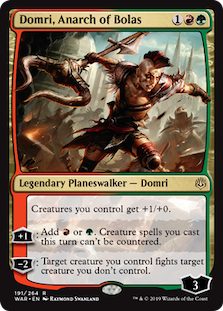 adequate threats to compliment Tarmogoyf. From our last jaunt around the block:
adequate threats to compliment Tarmogoyf. From our last jaunt around the block:
Outside of namesake nut-draws chaining Faithless Looting into turbo-charged Tarmogoyfs, TURBOGOYF has always had a problem establishing an adequate clock. I’ve looked to closers such as Goblin Rabblemaster, Huntmaster of the Fells, Siege Rhino, Goblin Dark-Dwellers, Stormbreath Dragon, Traverse the Ulvenwald (as extra Goyfs), Chandra, Torch of Defiance, Nahiri, the Harbinger, Bloodbraid Elf, and Hazoret the Fervent. Evidently, few of these have stuck.
Domri, Anarch of Bolas, Seasoned Pyromancer, and Wrenn and Six had just come in like wrecking balls, enabling Goblin Rabblemaster to assume a reliable damage-oriented role; combined with Looting, Pyromancer gave the deck a huge burst of velocity. But without Looting in the picture, too many three-drops can clog early. Stoneforge Mystic presents an alluring option as an early, must-answer threat that generates value even when sniped on-site.
Swordly Missed
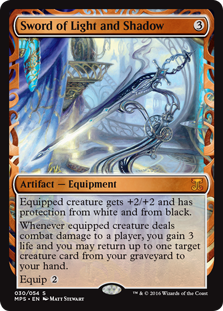 Equipment isn't totally new to GRx Moon. Early in the deck's lifespan, I ran as many as 3 Sword of Light and Shadow to protect Goyf, Huntmaster of the Fells, and Magus of the Moon from relevant removal and retrieve late Lhurgoyfs from the graveyard. As Modern sped up, and the deck evolved to fit more proactive threats, the Swords quickly lost favor. But as part of a streamlined Stoneforge package, Light and Shadow can once again rear its head in the archetype; Fatal Push and Path to Exile are the premier removal options when it comes to beefier threats, and much of our deck already resists Lightning Bolt when given +2/+2.
Equipment isn't totally new to GRx Moon. Early in the deck's lifespan, I ran as many as 3 Sword of Light and Shadow to protect Goyf, Huntmaster of the Fells, and Magus of the Moon from relevant removal and retrieve late Lhurgoyfs from the graveyard. As Modern sped up, and the deck evolved to fit more proactive threats, the Swords quickly lost favor. But as part of a streamlined Stoneforge package, Light and Shadow can once again rear its head in the archetype; Fatal Push and Path to Exile are the premier removal options when it comes to beefier threats, and much of our deck already resists Lightning Bolt when given +2/+2.
I also tried Sword of Feast and Famine, thinking the ability to untap all my lands and make more plays in Main 2 would gel with the deck's sifting nature. But Goyfblade can't really do that without Faithless Looting, needing to rely solely on Seasoned Pyromancer to meet its velocity needs. In the end, that extra mana was often superfluous.
Bolts and Greaves
Regardless, I knew I wanted three pieces of equipment in the deck to ensure Stoneforge would remain live in the mid-game. I ended up settling on Lightning Greaves, an old favorite that's never had much of a place in Modern. Alongside Stoneforge, though, we're seeing it crop up in creature-combo decks, and I think it might have a place in "big aggro" strategies like Goyf.dec and even Eldrazi. Being searchable makes Greaves significantly better, as gameplans can be sculpted around the card without needing to run multiple copies (any beyond the first are more or less dead).
 Having Greaves on the battlefield forces opponents to respect the threat of an immediate 4-8 damage, as well as a sudden life point swing—we can drop Stoneforge, search Skull, suit up the Kor, tap it to cheat out Skull, and then grant our lifelinking, vigilance Germ shroud and haste. The shroud function can also protect threats holding Sword of Light and Shadow, turning evasive creatures like Birds of Paradise into tough-to-contest value engines.
Having Greaves on the battlefield forces opponents to respect the threat of an immediate 4-8 damage, as well as a sudden life point swing—we can drop Stoneforge, search Skull, suit up the Kor, tap it to cheat out Skull, and then grant our lifelinking, vigilance Germ shroud and haste. The shroud function can also protect threats holding Sword of Light and Shadow, turning evasive creatures like Birds of Paradise into tough-to-contest value engines.
Then there's Batterskull itself, a major reason to dip into Stoneforge at all. I wouldn't consider playing her without the living weapon, but Skull doesn't do much for us it doesn't do elsewhere, so we won't spend much time on it.
Man-a Down
In "Back Again: Arclight Phoenix Rises over Modern," I introduced the idea of strategic curving, or deckbuilding that respected the stage of a game in which cards are best resolved, irrespective of their manacosts. Without Looting to dig for properly-curving follow-up plays, and Stoneforge bursting into the two-drop slot, Goyfblade's strategic curve remains up in the air.
A New Magic Number
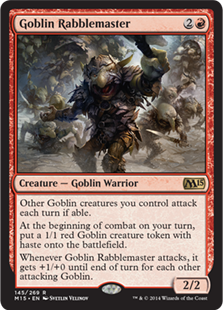 TURBOGOYF's strategic curve felt effortless. We'd keep hands with a mana dork or Wrenn, or with Looting in a pinch; that gave us 16 cards that okayed our openers. If our mana dork was killed, we could follow with Goyf/Wrenn, or with a removal spell and Looting/dork to set up for the next turn. If not, we had Moon, Pyromancer, and Rabblemaster to capitalize on the extra mana. Other games, we'd use Looting to set up the second turn, finding a second land or Goyf/Wrenn to begin clocking opponents.
TURBOGOYF's strategic curve felt effortless. We'd keep hands with a mana dork or Wrenn, or with Looting in a pinch; that gave us 16 cards that okayed our openers. If our mana dork was killed, we could follow with Goyf/Wrenn, or with a removal spell and Looting/dork to set up for the next turn. If not, we had Moon, Pyromancer, and Rabblemaster to capitalize on the extra mana. Other games, we'd use Looting to set up the second turn, finding a second land or Goyf/Wrenn to begin clocking opponents.
Adding Stoneforge and removing Looting mucks things up a bit. Goyf, Wrenn, and Stoneforge are all two-drops at their best deployed on an empty board while opposing shields are down. In other words, there aren't much better ways to chase a deceased dork. On the other hand, our critical mana point shifting from three to two has its share of drawbacks.
The new curve actually feels more cohesive when opponents kill our one-drop. If they don't, we've just got Moon and Pyromancer to punish them with. While the former remains an excellent option, and has defined the deck since I first built it, the latter leaves something to be desired without Looting in the picture. The sorcery let us sift through extra lands drawn naturally or recouped with Wrenn, while 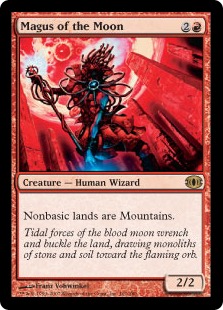 Pyromancer chewed past Sprawls and Moons to buff Goyf while creating 1/1s. But now, Pyromancer finds itself ruefully towing the fields, since we have no other way to turn our lands those into fresh meat. A 2/2 is much less impressive than the four-power bursts we're used to generating.
Pyromancer chewed past Sprawls and Moons to buff Goyf while creating 1/1s. But now, Pyromancer finds itself ruefully towing the fields, since we have no other way to turn our lands those into fresh meat. A 2/2 is much less impressive than the four-power bursts we're used to generating.
Rabblemaster previously filled the gap, being an excellent turn-two play that pressured opponents via multiple bodies. But the hefty Stoneforge package makes it tougher to fit, especially alongside Domri, Anarch of Bolas; that planeswalker is what turned Rabblemaster from a fringe consideration of times past into proper pressure. Instead, I've returned to Magus of the Moon, additional functional copies of Blood Moon. If opponents kill our dork, no problem; we'll follow with Goyf or Stoneforge, and the Magus is all but insured on turn three. If they don't, Magus is free to resolve and probably to stick around, since any existing kill spell would likely have been pointed at the dork by then.
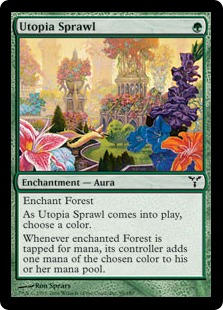 Other Changes
Other Changes
We have a couple more new developments to discuss, mostly pertaining to card types.
New Dorks on the Block
Gone from this version are Arbor Elf and longstanding pseudo-dork Utopia Sprawl. Sprawl was long favored as an accelerant because of its resilience to commonly played removal like Bolt and Push. But as we'd just as well have our dorks die in this version, less robust, but higher-utility dorks like Hierarch and Birds get the nod.
In the previous version, Arbor was insane, ramping us large amounts and facilitating the mana-hungry Looting plan; we could use Arbor for mana while trading our drawn and recurred lands into the graveyard for business from the deck. But between ditching Sprawl and Domri and adding a third color, Arbor loses a lot of stock as a dork.
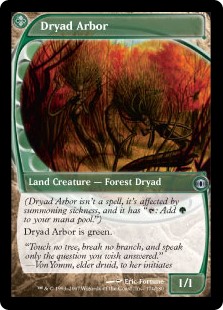 Noble Hierarch is widely considered the best dork in Modern; in this deck, it plays second fiddle to Birds of Paradise. Exalted is nice, sure, but casting Pyromancer off Hierarch is pretty tricky. Birds gives us choice galore on how to spend our mana, and man does it carry a Sword.
Noble Hierarch is widely considered the best dork in Modern; in this deck, it plays second fiddle to Birds of Paradise. Exalted is nice, sure, but casting Pyromancer off Hierarch is pretty tricky. Birds gives us choice galore on how to spend our mana, and man does it carry a Sword.
While it's not exactly a mana dork (until, God willing, Green Sun's Zenith comes off the banlist), Dryad Arbor is still a green creature that taps for colors. We've discussed its utility alongside Wrenn, which allows Arbor to chump block or attack each turn. This utility is increased with Stoneforge Mystic in the mix. Even if the Kor should die, the equipment it's fished out can be endlessly picked up by the fetchable, recurrable Arbor. And connecting with the Sword-equipped Forest retrieves our dead Stoneforge. Similarly, the 1/1 tokens created by Seasoned Pyromancer gain relevance with Sword.
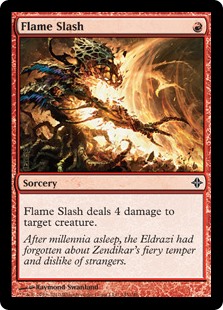 Sorceries
Sorceries
Maxing out Tarmogoyf is the pet project that drew me to GRx Moon shells in the first place, and I wasn't about to stop here. But it seems that without Faithless Looting, there are precious few sorceries playable in this style of deck. After trying options as diverse as Forked Bolt (not enough targets) and Light Up the Stage (not enough triggerers), I landed on just a pair of Flame Slashes. Slash is pretty nice right now, as it kills Thing in the Ice as well as freshly-deployed Stoneforges and even 4/4 Germs.
Sideboard
As always, with a new build and meta comes a new sideboard.
- Damping Sphere, Collector Ouphe, Rest in Peace: anti-combo options to combat Tron, Storm, Urza, Dredge, and the like.
- Ancient Grudge, Knight of Autumn: Stoneforge breakers, with the latter also pulling weight vs. Burn.
- Path to Exile: For when Moon isn't good enough or we need to remove lots of creatures, like against Jund or Humans.
- Veil of Summer: A fun bullet for midrange and control decks. Could be anything.
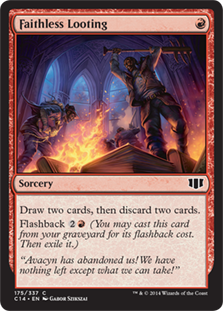 Edging 'Em Out
Edging 'Em Out
Stoneforge Mystic changes GRx Moon significantly, as does losing a core component in Faithless Looting. I'm not sure how optimistic to be about the deck's future, but only testing will tell if Goyfblade can keep up with its immediate predecessor. One thing's for sure: the interplay between Stoneforge, and Wrenn, and Arbor has taken me by surprise, and I'm excited to see Stoneforge emerge as a plan in more non-traditional homes over the coming months!




